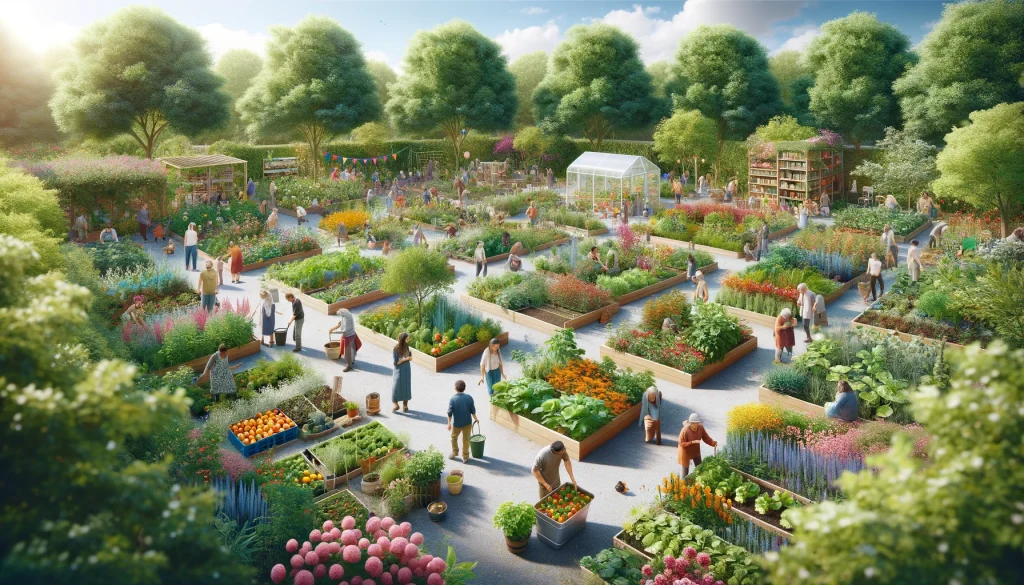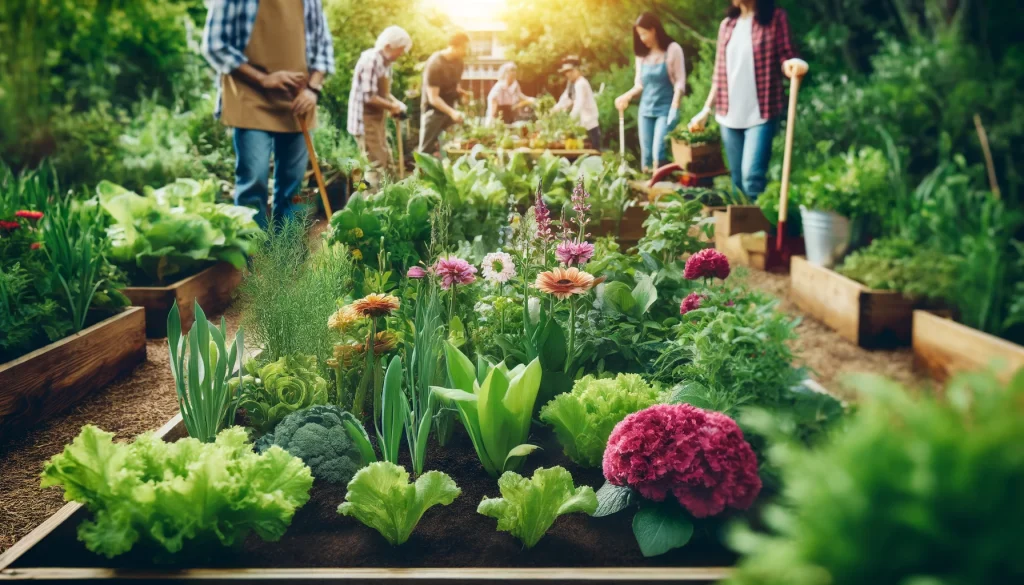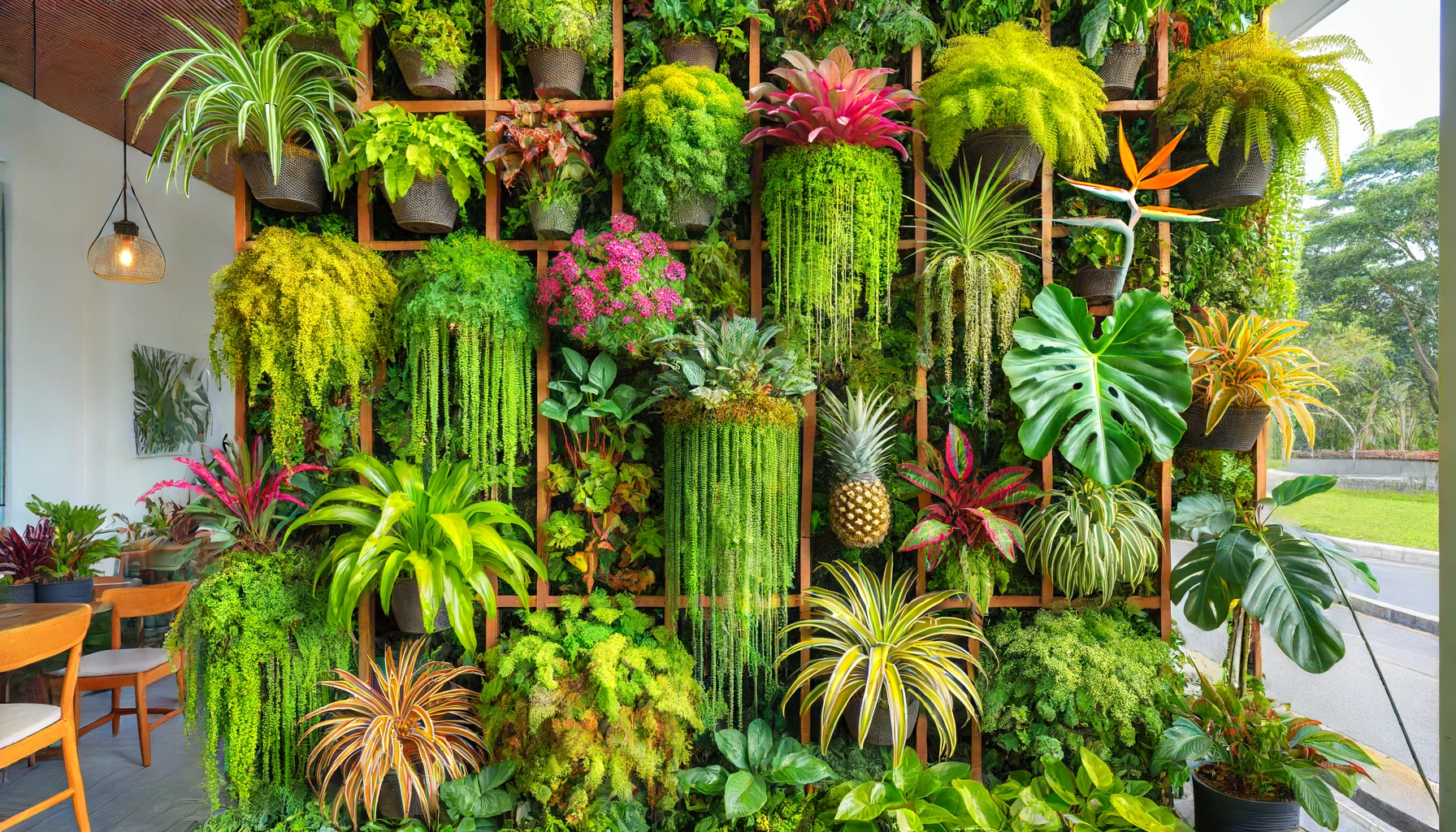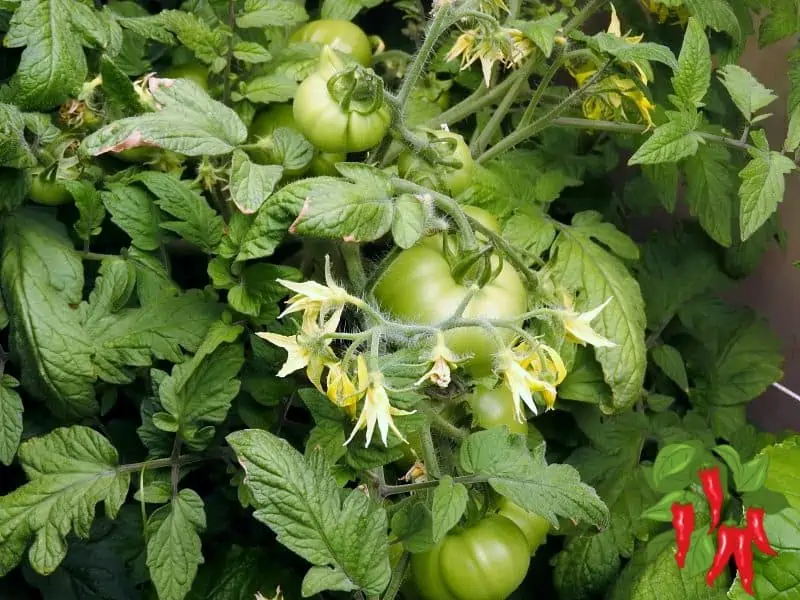This post may contain affiliate links. If you buy something from one of our links we may earn a commission. Thanks

Welcome to the wonderful world of community gardening! The Benefits of Community Gardening extend far beyond just growing plants.
From improving health and nutrition to building stronger communities, there’s so much to discover.
Let’s dive into how community gardening can transform your life and your neighborhood.
Community Garden Benefits Key Takeaways:
- Community gardening advantages include improved physical and mental health.
- Increased access to fresh produce, stronger community bonds, and enhanced local environments.
- These gardens offer opportunities for learning, economic benefits, and crime reduction, making them a vital part of urban and rural areas.
Benefits of Community Gardening
Howdy, everyone! If you’re looking for a way to improve your health, meet new folks, and make your neighborhood a nicer place, community gardening is the way to go. The Benefits of Community Gardening go way beyond just growing plants. Let’s see how this can change your life and your community!
Brief Overview of Community Gardening
Community gardening is all about folks coming together to grow plants in a shared space.
These gardens can pop up in urban areas, schools, and neighborhoods, giving people a chance to get their hands dirty and connect with nature and each other.
Importance of Understanding the Benefits
Knowing the benefits of community gardening can inspire more people to join in and reap the rewards.
These gardens offer fresh produce, improve health, build strong community bonds, and help the environment, making them a win-win for everyone involved.
1. Health and Nutrition Benefits
Roll up your sleeves and grab your gardening gloves, because diving into community gardening offers more than just a green thumb!
From boosting your physical activity to enhancing your diet with fresh, homegrown veggies, the Health and Nutrition Benefits of community gardening are as abundant as the harvest itself.
Let’s dig into how tending to a garden plot can cultivate better physical and mental wellness.
Physical Health
- Increased Physical Activity: Gardening gets you moving. Whether you’re digging, planting, or weeding, you’re getting a good workout. This activity helps reduce obesity rates by keeping you active.
- Reduced Obesity Rates: Regular physical activity in the garden can help manage weight and reduce the risk of obesity-related diseases.
Nutrition
- Access to Fresh, Locally Grown Produce: One of the best parts of community gardening is the fresh fruits and vegetables. There’s nothing like picking a ripe tomato or fresh greens straight from the garden.
- Improved Diet and Nutrition: Growing your own produce means you eat more fruits and vegetables, leading to a healthier diet. It’s a simple way to improve your nutrition and enjoy delicious, homegrown food.
Mental Health
- Reduced Anxiety, Stress, and Depression: Spending time in the garden can work wonders for your mental health. The contact with nature and the act of nurturing plants can reduce stress and anxiety levels.
- Nature Contact and Physical Activity: Both nature and exercise are known to boost mood and mental well-being. Community gardening combines both, making it a powerful tool for mental health improvement.
By joining a community garden, you not only get to enjoy fresh produce but also improve your physical and mental health. It’s a fulfilling way to stay active, eat healthily, and feel better overall.
2. Introduction to Social and Community Benefits

Community gardens are more than just patches of soil for planting; they are vibrant hubs of activity that knit tighter community fabrics.
From sparking new friendships to enriching cultural understanding, the Social and Community Benefits of community gardening foster a thriving, inclusive environment.
Let’s explore how these gardens cultivate stronger bonds and community spirit.
Social and Community Benefits
Social Connections
- Building Friendships: Community gardens are the perfect place to meet and mingle with neighbors. As you plant and nurture your garden, you also grow lasting friendships.
- Reducing Loneliness: For many, especially the elderly and isolated individuals, community gardens serve as a gathering place that combats loneliness and provides a sense of belonging.
- Fostering Community Bonds: Shared garden responsibilities and successes create strong ties among participants, enhancing mutual support and camaraderie.
Community Engagement
- Communal Events: Gardens often host various events such as harvest festivals, planting days, and educational workshops, which invite greater community involvement.
- Workshops and Educational Programs: These programs not only teach gardening skills but also topics like sustainability and nutrition, engaging community members of all ages in continuous learning.
Cultural Exchange
- Promoting Diversity and Cultural Understanding: Gardens attract participants from diverse backgrounds, offering an excellent opportunity for cultural exchange and interaction. Community gardens can become melting pots of traditions and techniques, enhancing cultural appreciation and understanding.
Building Stronger Communities
- Enhancing the Sense of Community and Neighborhood Pride: Successful community gardens can transform neighborhoods by instilling pride among residents who contribute to beautifying their environment. These gardens often become points of pride and central to neighborhood identity.
By fostering social connections, encouraging community engagement, and promoting cultural exchanges, community gardens significantly enhance social cohesion and community resilience. They are not just places to grow food but spaces to grow healthier, more connected communities.
3. Introduction to Economic Benefits
Dig into the fertile ground of community gardening and you’ll find a treasure trove of economic benefits.
Community gardens don’t just grow plants; they grow opportunities for local economies, enhance property values, and bolster food security.
Let’s delve into how these green spaces can also mean more green in more ways than one.
Economic Benefits
Local Economy
- Opportunities for Selling Produce: Community gardens provide a platform for gardeners to sell their surplus produce at local farmers’ markets, contributing to local income and fostering entrepreneurship.
- Offering Gardening Services: Skilled gardeners can offer their expertise for hire, providing services like garden design, maintenance, or educational workshops, which injects additional economic activity into the community.
Property Values
- Increased Property Values: Well-maintained community gardens can enhance the aesthetic appeal of a neighborhood, which can lead to increased property values. The presence of a vibrant community garden can make the area more desirable to potential buyers and renters.
- Neighborhood Beautification: Gardens help beautify neighborhoods, transforming vacant or underused lands into lush, green spaces that attract positive attention and community pride.
Food Security
- Reducing Food Insecurity: Community gardens play a critical role in enhancing food security, especially in urban and low-income areas. By providing access to fresh produce, these gardens help mitigate the impact of food deserts, offering fresh alternatives to food purchased from stores.
- Empowerment Through Self-Sufficiency: Growing their own food gives community members a sense of empowerment and self-reliance, reducing dependency on external food sources and minimizing the overall food-related expenses for families.
Community gardens are a vital asset in nurturing healthier economies as much as they do in cultivating crops. They not only provide economic opportunities at a local level but also contribute to an overall improvement in community well-being by ensuring access to fresh, affordable food and enhancing the living environment.
4. Introduction to Educational Opportunities
Community gardens are not just about cultivating plants, but also nurturing minds.
These vibrant spaces offer a rich soil for educational opportunities, where both young and old can learn about sustainable agriculture, develop crucial life skills, and engage actively in environmental stewardship.
Let’s explore how community gardens serve as classrooms without walls.
Educational Opportunities
Hands-On Learning
- Teaching Sustainable Agriculture: Community gardens provide a practical setting to learn and implement sustainable agricultural practices. Participants get hands-on experience with techniques such as crop rotation, organic pest control, and composting.
- Environmental Stewardship: Gardening encourages a deep connection with the environment, teaching participants about biodiversity, conservation, and the importance of maintaining healthy ecosystems.
Skill Development
- Developing Life Skills: Community gardening offers more than just agricultural skills. It teaches patience, as gardeners wait for their crops to grow; responsibility, through regular watering and weeding; and teamwork, as plots are often managed cooperatively.
- Empowerment and Leadership: Working in a garden can empower individuals, giving them the confidence to make decisions and lead projects, which are valuable skills transferable to many areas of life.
Youth Engagement
- Involving Children in the Food Supply Chain: Community gardens are excellent for educating children on where food comes from. They can see the process from seed to table, which is often lost in urban settings.
- Outdoor Learning: Gardens provide a dynamic environment for children to learn science, math, and more. For example, measuring plant growth can be a practical math lesson, and observing insects becomes a lesson in biology.
Community gardens are invaluable as educational resources, providing a dynamic environment for practical learning and personal development.
Through active participation in gardening, community members of all ages can gain a better understanding of the world around them and their role in shaping a sustainable future.
5. Introduction to Environmental Benefits

Community gardens are not just patches of greenery; they are vital eco-warriors in the heart of our cities.
These green spaces play a crucial role in enhancing urban environments by improving air quality, reducing heat, and promoting sustainable living practices.
Let’s uncover how community gardens contribute to a healthier planet.
Environmental Benefits
Green Spaces
- Creating Urban Green Spaces: Community gardens transform underutilized urban areas into vibrant green spaces that provide a respite from concrete jungles. These areas contribute significantly to urban biodiversity by supporting various plant and animal species.
- Improving Air Quality: Plants in community gardens help filter pollutants and fine particulates from the air, which is especially beneficial in urban settings where air quality may be compromised.
- Reducing Urban Heat Islands: Vegetation and soil in gardens help cool the air, reducing the urban heat island effect that can make city centers much hotter than their rural surroundings. This not only makes cities more comfortable to live in but also reduces the need for air conditioning, thus saving energy.
Sustainability
- Promoting Composting: Community gardens often include composting programs that recycle organic waste into rich soil nutrients, reducing landfill waste and chemical fertilizers use.
- Water Conservation: These gardens encourage the use of sustainable watering practices, such as drip irrigation and rainwater harvesting, which conserve water — a critical resource in many urban areas.
- Sustainable Practices: Many gardens also educate participants on other sustainable practices like using renewable energy sources, creating wildlife habitats, and practicing organic gardening, which avoids the use of harmful pesticides and herbicides.
Community gardens are powerful allies in the fight against environmental degradation, promoting not only greener, but also cleaner, cooler, and more sustainable urban areas.
Through these gardens, communities can take active roles in preserving their local environments, making them better places to live for current and future generations.
6. Introduction to Public Safety and Community Well-being
In the heart of community gardening lies not just the growth of plants, but also the blossoming of safety and well-being.
These gardens do more than beautify neighborhoods; they transform them into vibrant, safe spaces where pride and collective well-being flourish.
Let’s delve into how community gardens are sowing seeds of safety and pride across neighborhoods.
Public Safety and Community Well-being
Crime Prevention
- Increased Neighborhood Vigilance: Community gardens encourage residents to spend more time outdoors, which naturally leads to greater vigilance and oversight in the area. This active presence can deter criminal activities.
- Transforming Vacant Lots: Turning neglected and unused urban spaces into thriving gardens can significantly reduce crime. Vacant lots often attract illegal activities, but when these spaces are transformed into community gardens, they become places of productivity and care instead of neglect and danger.
Community Pride
- Fostering a Sense of Ownership and Pride Among Residents: When community members invest time and energy into cultivating a garden, they also cultivate a sense of ownership and pride in their surroundings. This emotional investment can lead to enhanced care for the community and an increase in neighborhood pride.
- Beautification and Positive Identity: Well-maintained and vibrant gardens not only enhance the aesthetic value of the area but also contribute to a positive community identity and spirit, making residents proud to call their neighborhood home.
Well-being
- Overall Enhancement of Community Well-being and Quality of Life: Community gardens provide a peaceful retreat from urban stress, offering a sense of tranquility and a place to relax, which can greatly enhance mental and physical health.
- Social Well-being: These gardens foster social interactions and create a community space that facilitates sharing, cooperation, and mutual help, which are crucial for emotional well-being.
Improved Neighborhood Safety
- Reduced Crime Rates Through Increased Community Presence: The regular gathering of community members in garden spaces increases the supervision and maintenance of these areas, which helps lower crime rates.
- Safety Through Environmental Design: Community gardens are examples of environmental design that promotes safety. Their layout and openness encourage visibility and accessibility, factors known to contribute to safer neighborhoods.
Community gardens do much more than grow food; they cultivate a culture of care, vigilance, and communal pride, significantly enhancing public safety and community well-being.
They prove that when communities come together to reclaim and nurture their environments, they also nurture their collective spirit and safety.
7. Introduction to Institutional and Organizational Benefits
Community gardens weave their green fingers through various institutions, bringing transformative benefits that extend beyond simple gardening.
From hospitals to prisons and churches, these gardens provide more than just food; they offer healing, reform, and spiritual connection.
Let’s uncover the profound impacts of community gardens across different organizations.
Institutional and Organizational Benefits
Hospitals
- Connecting Patients with Healthier Food Options: Hospitals use community gardens to provide patients with access to fresh, nutritious produce, enhancing their diet and supporting faster recovery. This not only improves patient care but also educates them on the importance of healthy eating for long-term wellness.
- Therapeutic Benefits: The act of gardening itself can serve as a form of therapy, helping patients reduce stress and improve mental health during recovery.
Prisons
- Supporting Rehabilitation and Reform Programs: Community gardens in prison settings offer inmates constructive activities, teach responsibility, and provide skills that can be useful upon reintegration into society. Gardening programs are often part of broader rehabilitation efforts, helping to reduce recidivism by instilling a sense of purpose and accomplishment.
- Emotional and Psychological Well-being: Engaging with nature can have a calming effect on inmates, fostering a more peaceful environment and aiding in emotional stability.
Churches
- Strengthening Connections Between Faith, Nature, and Food: Many churches have embraced community gardens as a way to nourish both body and spirit. These gardens can be seen as extensions of their community services, providing fresh produce to those in need and a space for reflection and connection with creation.
- Community Outreach and Engagement: Gardens offer a unique venue for churches to engage with the community, bringing people together in a peaceful setting and helping to build stronger, more supportive networks among congregants and neighbors.
Community gardens in institutional settings do more than simply fill empty spaces with greenery.
They help heal, reform, nourish, and connect people in profound ways, making them invaluable assets to any organization looking to make a positive impact on its community.
8. Introduction to Personal Development and Well-being

Community gardens are not just about planting seeds in the soil; they’re about planting ideas in minds and cultivating a sense of peace in hearts. They offer a fertile ground for personal growth and wellness, where gardeners can flourish alongside their crops. Let’s dig into how tending to a garden nurtures the gardener too.
Personal Development and Well-being
Gardening Knowledge and Expertise
- Learning and Sharing Gardening Techniques: Community gardens are fantastic places for both novice and experienced gardeners to learn and exchange knowledge about gardening techniques. Whether it’s mastering the art of composting, understanding the nuances of crop rotation, or learning organic pest control methods, gardeners expand their horticultural skills in a community setting.
- Mentorship and Continuous Learning: More experienced gardeners often take on mentoring roles, helping newcomers navigate the challenges of gardening. This not only strengthens gardening skills but also builds leadership qualities and teaching abilities.
Relieving Stress and Increasing Wellness
- Connecting with Nature: Spending time in a garden allows individuals to connect with nature, which is known to offer significant stress relief. The simple acts of planting, weeding, and watering are meditative and can help reduce overall stress levels.
- Engaging in Constructive Activities: Gardening is a proactive and productive use of time. It provides a sense of accomplishment which is crucial for mental health. Regular engagement in such activities can improve mood, increase self-esteem, and reduce feelings of depression or anxiety.
- Physical Activity: Gardening involves various physical activities that contribute to physical health. It’s a form of exercise that can improve stamina, strength, and flexibility, contributing to overall physical wellness.
Community gardens provide a unique blend of physical, mental, and emotional benefits, making them more than just places to grow food.
They are spaces where people can grow personally and find a deeper connection to the environment and their community.
Community Garden Benefits FAQs
Hey there, garden enthusiasts! Got some burning questions about community gardening? Well, you’re in the right place. Here’s a handy Q&A that’ll help you get to the root of why community gardens are such a fantastic part of any neighborhood. So, let’s get those questions answered!
Q. How can I get involved in a community garden?
A. Getting involved is easier than you might think! Start by checking if your neighborhood has an existing garden. Local community centers, libraries, or city websites often have information on nearby gardens. If there’s one, reach out and ask how you can join. No garden nearby? Consider starting one! Gather a group of interested neighbors and look for potential spaces like vacant lots that could be converted into a green space.
Q. What are the health benefits of community gardening?
A. Community gardening is a healthy activity in more ways than one! Physically, it gets you moving and grooving outside, which is great for maintaining a healthy weight and reducing the risk of chronic diseases. Mentally, it’s a stress buster. Being in nature and getting your hands dirty can significantly decrease stress and improve your mood.
Q. How do community gardens improve food security?
A. Community gardens are powerful tools for enhancing food security, especially in urban areas where access to fresh produce can be limited. They provide fresh fruits and veggies to community members, often at a lower cost or for free, helping to ensure that everyone has access to nutritious food options.
Q. What economic benefits do community gardens provide?
A. These green spaces can sprout economic growth by providing local produce for sale, creating jobs related to garden maintenance and education, and even boosting local property values. Gardens can transform neighborhoods, making them more attractive and inviting, which in turn can attract more business and investment.
Q. How do community gardens help the environment?
A. Community gardens contribute positively to the environment by increasing green space, which helps to improve air quality and reduce urban heat islands. They often promote sustainability through practices like composting and water conservation, and they provide vital habitats for wildlife.
Q. Can community gardens reduce crime in neighborhoods?
A. Absolutely! Gardens can help lower crime rates by increasing the visibility of community members who actively care for the area. This increased vigilance can deter potential criminal activity. Plus, transforming vacant lots into beautiful and cared-for spaces can reduce the spots that might otherwise attract negative behaviors.
Got more questions or need tips on getting your green thumbs dirty? Just ask, and let’s keep our communities growing strong and green!
Community Gardening Benefits: Conclusion
Well, howdy folks! We’ve dug deep into the world of community gardening and unearthed a whole heap of benefits it brings to folks like you and me, and our neighborhoods.
Whether you’re looking to boost your health, make friends, or just do some good for your town, community gardens provide a patch of green where you can do it all.
Let’s wrap this up with some final thoughts on why getting your hands dirty can be a wholesome part of your daily life.
Key Takeaways
- Health Boost: Community gardens are great for physical and mental health, offering a natural way to stay fit and de-stress.
- Social Sprouts: These gardens help forge strong bonds with neighbors, creating friendships and enhancing community cohesion.
- Economic Growth: They can spur local economic benefits, from reducing grocery bills to boosting property values.
- Environmental Impact: Gardening locally helps reduce our carbon footprint, manage stormwater, and beautify our cities.
- Safety and Pride: Cultivating garden spaces can also cultivate safer, prouder, and more engaged communities.
Get Involved!
Don’t just stand there on the sidelines! If you’ve got a local community garden, why not jump in? No garden in your area? Maybe it’s time you started one. You’ll find it’s a rewarding way to contribute to your community’s health and happiness.
The Bigger Picture
Community gardens are more than just food producers; they are vital tools for building healthier, happier, and more connected communities. They show us how getting back to our roots and working together can make a real difference in our lives and the lives of our neighbors.
Read more: 6 Benefits of Gardening: Gardening’s Big Payoffs
So, why not grab a shovel, plant some seeds, and see how much joy and growth your efforts can bring? Let’s keep our communities green and our spirits even greener. Happy gardening, y’all, and remember—stay green!
Community Gardening Resources
Howdy folks! If you’re itching to get involved with community gardening, or maybe just curious about where to dig up more information, you’re in luck.
I’ve rounded up a bunch of resources to help you get your garden gloves on some valuable insights and connections.
American Community Gardening Association (ACGA)
The ACGA is a treasure trove for anyone looking to start or join a community garden. They offer a plethora of resources, from how to get your garden off the ground to connecting with other gardeners.
You can find guides, tips, and even an interactive map to locate gardens near you. Check them out here.
Urban Harvest
For those of you closer to Houston or just interested in how community gardens can function in urban environments,
Urban Harvest is a great resource. They oversee a network of over 160 affiliate gardens and offer tons of support through education and resources for sustainable gardening. Dive into what they offer here.
NC State Extension
If you’re after a more structured approach to starting a community garden, NC State Extension has a comprehensive guide that covers everything from planning and management to overcoming common problems.
They provide practical tools like sample layouts and budget plans which can be quite handy. Learn more from their guide here.
American Horticultural Society
For those looking to deepen their gardening knowledge, the American Horticultural Society offers a wide range of educational resources, publications, and gardening programs.
They are particularly useful for anyone wanting to connect with gardeners across North America or find literature on specific gardening topics. Explore their resources here.
These resources should give you a solid starting point for either jumping into community gardening or enhancing your existing gardening efforts.
Whether you’re a novice looking to plant your first seeds or a seasoned green thumb aiming to expand your impact, there’s something in the garden world waiting for you.
Happy gardening, y’all, and remember—keep it green!






